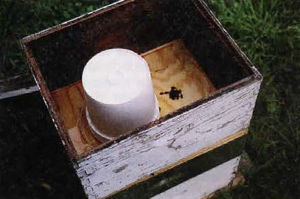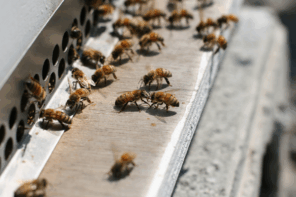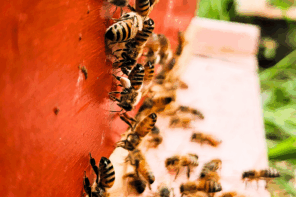By: Ross Conrad
This article originally appeared in the Spring 2017 issue of BEEKeeping Your First Three Years
Honey Bee Packages
The majority of beekeepers in the U.S. today get their start by purchasing a package of bees with a mated queen included. Bee packages can also be used to replace dead colonies or rejuvenate colonies that are weak and have a low population.
This article is intended to provide a quick overview of whether a package of bees will work for you in your situation, suggest questions you should consider asking your packaged bee supplier, and take a look at some of the things that can go wrong with packaged bees and what to do when it does.
What is a package of bees?
 A package typically contains bees and a separately caged queen with several worker bees to attend to her, all enclosed within a screened box. These screened shipping boxes come in different sizes ranging from two to four pounds of worker bees, though three pound packages (containing about 10,000 bees) are most common. Packaged bees are also shipped with a pint can of sugar syrup to keep them fed until they can be installed in their new hive. Bees for packaging usually are shaken from the brood combs of strong colonies, so that mostly young adult bees will be included. The bees are shaken through a funnel into the packages or into a “shaker box” until about 10 pounds of bees have accumulated; then several packages are filled from the shaker box. Cages for shipping packages are made of wood and screen, in a way that combines lightweight, sturdiness, and a maximum of screened area through which the bees can ventilate their cluster and prevent overheating.
A package typically contains bees and a separately caged queen with several worker bees to attend to her, all enclosed within a screened box. These screened shipping boxes come in different sizes ranging from two to four pounds of worker bees, though three pound packages (containing about 10,000 bees) are most common. Packaged bees are also shipped with a pint can of sugar syrup to keep them fed until they can be installed in their new hive. Bees for packaging usually are shaken from the brood combs of strong colonies, so that mostly young adult bees will be included. The bees are shaken through a funnel into the packages or into a “shaker box” until about 10 pounds of bees have accumulated; then several packages are filled from the shaker box. Cages for shipping packages are made of wood and screen, in a way that combines lightweight, sturdiness, and a maximum of screened area through which the bees can ventilate their cluster and prevent overheating.
Readily Available
Packaged bees are the most abundant option available to someone looking to get a new hive started. Most queens and packaged bees are produced by beekeepers who concentrate on this specialty within the beekeeping industry. For the most part, such operations are located in mild wintering areas that allow queen and bee production during the Winter and Spring … the time when most people want to receive delivery of their bees.
One of the Least Expensive Options
Purchasing a package of bees is the least expensive option available for getting a hive started next to capturing a swarm or being given bees as a gift. This is in part because of the abundance of package producers in the country and because the price of equipment is excluded when bees are purchased as a package rather than as part of a nucleus colony or complete hive. In 2017, you can expect a three-pound package of bees to typically cost somewhere between $99 to as much as $160 or more, plus shipping. Much depends on the size of the package and the type of bees you are purchasing with bees that have the potential for disease and mite resistance tending to come in at the high end.
Super Convenient
Packaged bees are one of the most convenient options for getting a colony of honey bees started. They may be shipped through the mail via the United States Postal Service or UPS right to your door or to your local post office. With a little advance planning and clear communication with your supplier, you should be able to arrange to have your bees arrive on the exact day that you want them.
Local or Distant Sources
When possible, finding a supplier that provides bees that are raised within your region is likely to be preferable in most instances. Besides helping to support your local community economically, when you buy bees raised locally they are more likely to be adapted to your local climate conditions. If you want local bees and are unable to find a local source for packages, but can find a local queen supplier, a package of bees can be purchased from a distant supplier and hived with the locally raised queen. Remember, the bees in a package are only there to support the queen as she gets her hive established. In five to six weeks, most if not all the bees that came in the package will have died and they will have been replaced with new bees from the eggs your queen is providing. Also, since travel time within the package can be stressful for the bees, the closer you are to your supplier the less miles the bees have to travel within the package. Contact your local or state beekeeping association if you need more information on who may have packages available in your area.
 Questions to Ask Your Queen and/or Package Supplier
Questions to Ask Your Queen and/or Package Supplier
• Where are the queens raised? Some queen and bee suppliers will purchase bees from another supplier and simply resell them.
• How have pests and diseases been managed in the hives? It is good to know the kind of care the bees have received and what treatments they have been exposed to, or what they haven’t been exposed to.
• How long will the bees be in the package? Do they ship the bees out the day they package them or will the bees be sitting around before the hit the mail?
• Is the queen raised from disease or mite resistant stock? Getting bees that have some ability to deal with diseases and pests will make your job easier.
• How long do you let the queen lay eggs before she is shipped? One of the problems with queens in recent years is that some suppliers are shipping out queens too early. Ideally, a queen will be allowed to lay eggs for at least two weeks before she is caged and shipped.
• How do you ship, and when will the bees be shipped? You need to know so you will know what to expect and you can be ready for the bees when they arrive.
• Have the bees been inspected? Many states have bee inspection programs and your supplier should be able to supply you with a copy of their inspection report if they have had their bees inspected.
What can go wrong and what to do when it does?
• Delays in shipping – Life happens. Suppliers can get backed up with orders. The weather can be uncooperative slowing down hive development and causing the bee supplier to get behind on their schedule. The best you can do in this situation is be patient. It also helps to plan your shipment of bees several weeks ahead of any expected trips so if there is a delay, your bees don’t end up arriving when you are planning to be out of town.
• Stress during shipment – Travel by Parcel Post is not the honey bee’s preferred method of transportation and it is stressful on them. Shipping your package overnight will help limit the amount of time the bees spend in this stressful situation. However, overnight shipping can be expensive. 1f your package is not being shipped overnight, have your supplier ship on a Monday or Tuesday so that the bees are most likely to arrive a day to two before the weekend. This provides a day or two buffer and will help prevent the poor critters from sitting in their shipping crate for an extra few days over a weekend should an unexpected delay occur. For the same reason, it is good to try to avoid having bees shipped around holidays. Have the supplier repeat your shipping address back to you after you provide it. This is a simple way to confirm that they have the correct shipping address and avoid delivery delays that can be lethal. If the supplier is close to you, it may be preferable to drive down and pick them up and take them home yourself. You want to get your bees transferred into their new hive and start feeding them ASAP. Therefore, be sure you have prepared all the equipment you will need to hive the bees, before your shipment arrives.
• Large bee die-off during shipment – While some dead bees in the bottom of the package can be expected upon arrival, the number should not be excessive. Lots of things that can happen during shipment, from trucks breaking down to packages being left in the sun or in places where their ability to ventilate becomes compromised. Unfortunately, many bee and queen suppliers relinquish responsibility for the condition of the bees once they are in the hands of the shipper. If most, or all of your bees appear to be dead when you receive your package, immediately file a claim with the shipper in order to get reimbursed for your loss. It is a good idea to photograph the package of dead bees in the presence of the delivery driver or postal clerk and submit the photo with your paperwork to help expedite a claim.
• Pests hitching a ride – Since a package of bees does not contain any comb, there is less of a chance that your bees will be infected with diseases or pests. However, it is still possible for packaged bees to harbor pests such as the Varroa mite or Small Hive Beetle, especially if they have not been treated or inspected prior to packaging and shipment. Be on the lookout for such pests when transferring the bees into their new hive. Varroa mites are ubiquitous these days and all bees have them, or will have them soon. Expect to see a mite or two if you are paying attention and looking closely. However, if more than a few varroa mites are observed on bees in the package, or during their transfer into their hive, consider a treatment option.
If small hive beetles are seen in with the packaged bees, install a beetle trap in the hive. Be sure to also match the size of the hive cavity to the population of bees and don’t add a second box until the first hive body is 80-85% filled with bees, brood, honey, pollen and drawn comb.
• The can of sugar syrup in the cage is empty – The sugar syrup provided with a package of bees typically is more than enough to keep the bees bellies full until they are transferred into their hive. However, if delays occur in shipping or there is a delay in transferring the bees and queen into a hive and feeding them, the can of syrup may become empty. To feed bees in a package that you suspect needs feeding, simply spray sugar syrup onto the bees through the package’s screening, and get them hived ASAP.
Honey bee packages can be a good way to get started in beekeeping. By planning ahead and asking the right questions, you may avoid some of the common pitfalls that can jeopardize your initial beekeeping success.









